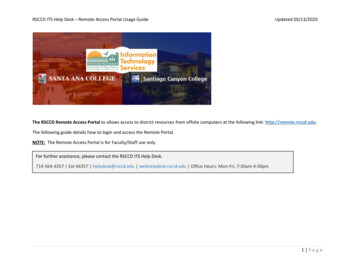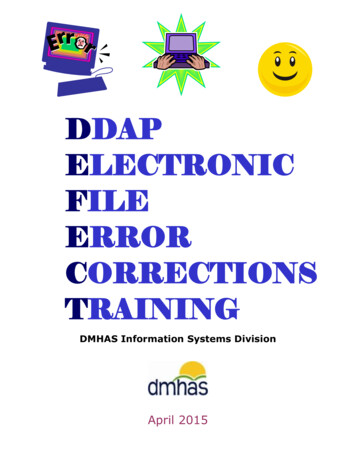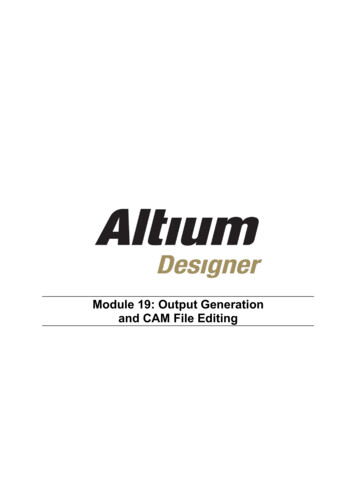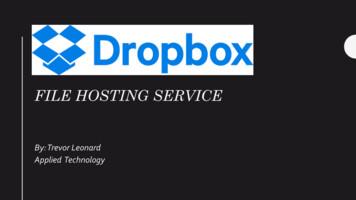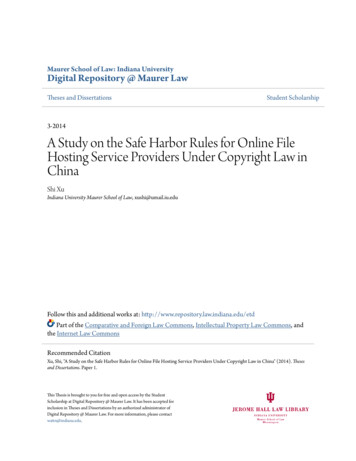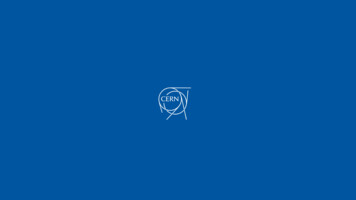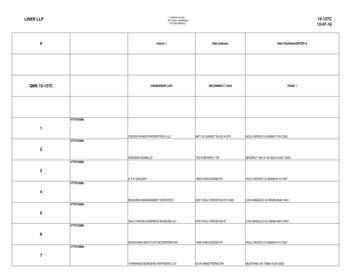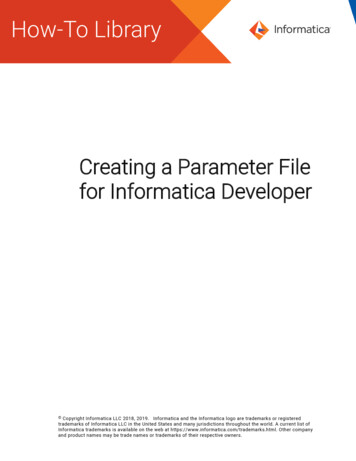![[MS-ACCDT]: Access Template File Format](/img/10/ms-accdt.jpg)
Transcription
[MS-ACCDT]:Access Template File FormatIntellectual Property Rights Notice for Open Specifications Documentation Technical Documentation. Microsoft publishes Open Specifications documentation (“thisdocumentation”) for protocols, file formats, data portability, computer languages, and standardssupport. Additionally, overview documents cover inter-protocol relationships and interactions.Copyrights. This documentation is covered by Microsoft copyrights. Regardless of any otherterms that are contained in the terms of use for the Microsoft website that hosts thisdocumentation, you can make copies of it in order to develop implementations of the technologiesthat are described in this documentation and can distribute portions of it in your implementationsthat use these technologies or in your documentation as necessary to properly document theimplementation. You can also distribute in your implementation, with or without modification, anyschemas, IDLs, or code samples that are included in the documentation. This permission alsoapplies to any documents that are referenced in the Open Specifications documentation.No Trade Secrets. Microsoft does not claim any trade secret rights in this documentation.Patents. Microsoft has patents that might cover your implementations of the technologiesdescribed in the Open Specifications documentation. Neither this notice nor Microsoft's delivery ofthis documentation grants any licenses under those patents or any other Microsoft patents.However, a given Open Specifications document might be covered by the Microsoft OpenSpecifications Promise or the Microsoft Community Promise. If you would prefer a written license,or if the technologies described in this documentation are not covered by the Open SpecificationsPromise or Community Promise, as applicable, patent licenses are available by contactingiplg@microsoft.com.License Programs. To see all of the protocols in scope under a specific license program and theassociated patents, visit the Patent Map.Trademarks. The names of companies and products contained in this documentation might becovered by trademarks or similar intellectual property rights. This notice does not grant anylicenses under those rights. For a list of Microsoft trademarks, visitwww.microsoft.com/trademarks.Fictitious Names. The example companies, organizations, products, domain names, emailaddresses, logos, people, places, and events that are depicted in this documentation are fictitious.No association with any real company, organization, product, domain name, email address, logo,person, place, or event is intended or should be inferred.Reservation of Rights. All other rights are reserved, and this notice does not grant any rights otherthan as specifically described above, whether by implication, estoppel, or otherwise.Tools. The Open Specifications documentation does not require the use of Microsoft programmingtools or programming environments in order for you to develop an implementation. If you have accessto Microsoft programming tools and environments, you are free to take advantage of them. CertainOpen Specifications documents are intended for use in conjunction with publicly available standardsspecifications and network programming art and, as such, assume that the reader either is familiarwith the aforementioned material or has immediate access to it.Support. For questions and support, please contact dochelp@microsoft.com.1 / 40[MS-ACCDT] - v20181001Access Template File FormatCopyright 2018 Microsoft CorporationRelease: October 1, 2018
Revision 3/20090.1MajorInitial Availability8/28/20090.2EditorialRevised and edited the technical content11/6/20090.3EditorialRevised and edited the technical content2/19/20101.0MajorUpdated and revised the technical content3/31/20101.01EditorialRevised and edited the technical content4/30/20101.02EditorialRevised and edited the technical content6/7/20101.03MinorUpdated the technical content6/29/20101.04EditorialChanged language and formatting in the technical content.7/23/20101.04NoneNo changes to the meaning, language, or formatting of thetechnical content.9/27/20101.04NoneNo changes to the meaning, language, or formatting of thetechnical content.11/15/20101.05MinorClarified the meaning of the technical content.12/17/20101.05NoneNo changes to the meaning, language, or formatting of thetechnical content.3/18/20111.05NoneNo changes to the meaning, language, or formatting of thetechnical content.6/10/20111.05NoneNo changes to the meaning, language, or formatting of thetechnical content.1/20/20121.6MinorClarified the meaning of the technical content.4/11/20121.6NoneNo changes to the meaning, language, or formatting of thetechnical content.7/16/20121.6NoneNo changes to the meaning, language, or formatting of thetechnical content.9/12/20121.6NoneNo changes to the meaning, language, or formatting of thetechnical content.10/8/20121.7MinorClarified the meaning of the technical content.2/11/20131.7NoneNo changes to the meaning, language, or formatting of thetechnical content.7/30/20131.8MinorClarified the meaning of the technical content.11/18/20131.9MinorClarified the meaning of the technical content.2/10/20141.9.1EditorialChanged language and formatting in the technical content.4/30/20141.10MinorClarified the meaning of the technical content.7/31/20141.10NoneNo changes to the meaning, language, or formatting of thetechnical content.2 / 40[MS-ACCDT] - v20181001Access Template File FormatCopyright 2018 Microsoft CorporationRelease: October 1, 2018
No changes to the meaning, language, or formatting of thetechnical content.2/26/20162.0MajorSignificantly changed the technical content.7/15/20162.0NoneNo changes to the meaning, language, or formatting of thetechnical content.9/14/20162.0NoneNo changes to the meaning, language, or formatting of thetechnical content.9/29/20162.0NoneNo changes to the meaning, language, or formatting of thetechnical content.7/24/20183.0MajorSignificantly changed the technical content.10/1/20184.0MajorSignificantly changed the technical content.Comments3 / 40[MS-ACCDT] - v20181001Access Template File FormatCopyright 2018 Microsoft CorporationRelease: October 1, 2018
Table of Contents1Introduction . 61.1Glossary . 61.2References . 61.2.1Normative References . 71.2.2Informative References . 71.3Structure Overview (Synopsis) . 71.4Relationship to Protocols and Other Structures . 81.5Applicability Statement . 81.6Versioning and Localization . 91.7Vendor-Extensible Fields . 92Structures . 102.1File Structure. 102.1.1Package . 102.1.2Part . 102.1.3Relationship . 102.1.4Part Enumeration. 112.1.4.1Application Properties . 122.1.4.2Data Macro . 122.1.4.3File Properties, Core . 122.1.4.4Form . 132.1.4.5Icon . 132.1.4.6Image . 132.1.4.7Image Cluster. 142.1.4.8Instantiation Form . 152.1.4.9Legacy Application Properties . 152.1.4.10Linked Table . 152.1.4.11List Definition . 152.1.4.12Macro . 162.1.4.13Navigation Pane . 162.1.4.14Object . 162.1.4.15Object Metadata . 162.1.4.16Object Properties . 172.1.4.17Preview Image. 172.1.4.18Query . 172.1.4.19Relationship . 182.1.4.20Report . 182.1.4.21Resource. 182.1.4.22Table Data . 192.1.4.23Template Metadata . 192.1.4.24Theme . 192.1.4.25Variation . 192.1.4.26Visual Basic References . 202.2Template Metadata. 202.2.1Global Elements . 202.2.1.1Template . 202.2.2Global Attributes. 202.2.3Complex Types . 202.2.3.1CT Template . 202.2.4Simple Types . 212.3Object Metadata . 212.3.1Global Elements . 212.3.1.1AccessObject . 212.3.2Global Attributes. 222.3.3Complex Types . 224 / 40[MS-ACCDT] - v20181001Access Template File FormatCopyright 2018 Microsoft CorporationRelease: October 1, 2018
2.3.3.1CT NameMap . 222.3.3.2CT AccessObject . 222.3.4Simple Types . 232.3.4.1ST Type . 232.4List Schema . 232.4.1Add Calculated Fields . 242.4.2Add Fields . 242.4.3Add List . 242.4.4Field Properties . 242.4.5List Properties . 242.5List Data . 252.5.1Data Instance . 252.5.2Schema . 253Structure Examples . 263.1List Schema . 263.2List Data . 293.3Images . 324Security . 344.1Security Considerations for Implementers . 344.2Index of Security Fields . 345Appendix A: Full XML Schemas . 05/04/template/start Schema . 05/04/template/object-metadataSchema . 356Appendix B: Product Behavior . 377Change Tracking . 388Index . 395 / 40[MS-ACCDT] - v20181001Access Template File FormatCopyright 2018 Microsoft CorporationRelease: October 1, 2018
1IntroductionThe Access Template File Format specifies the Access Template File Format (.accdt). This File Formatis a collection of structures used to define a database application. These structures can includeschemas for storing data, the data to be stored, layout descriptions for views of the data, actionscontrolling workflow, and metadata describing the database application as a whole.Sections 1.7 and 2 of this specification are normative. All other sections and examples in thisspecification are informative.1.1GlossaryThis document uses the following terms:Augmented Backus-Naur Form (ABNF): A modified version of Backus-Naur Form (BNF),commonly used by Internet specifications. ABNF notation balances compactness and simplicitywith reasonable representational power. ABNF differs from standard BNF in its definitions anduses of naming rules, repetition, alternatives, order-independence, and value ranges. For moreinformation, see [RFC5234].calculated field: A user-defined field that can perform calculations by using the contents of otherfields.database application: A set of objects, including tables, queries, forms, reports, macros, andcode modules, that are stored in a database structure.database object: An object such as a table, query, form, report, macro, or module that can bereferenced by name in a database, database application, or database project.database template: A file that contains the data and component descriptions that are needed tocreate or instantiate a database application.field: A discrete unit of a record that has a name, a data type, and a value.list: A container within a SharePoint site that stores list items. A list has a customizable schemathat is composed of one or more fields.list item: An individual entry within a SharePoint list. Each list item has a schema that maps tofields in the list that contains the item, depending on the content type of the item.sort order: A set of rules in a search query that defines the ordering of rows in the search result.Each rule consists of a managed property, such as modified date or size, and a direction fororder, such as ascending or descending. Multiple rules are applied sequentially.MAY, SHOULD, MUST, SHOULD NOT, MUST NOT: These terms (in all caps) are used as definedin [RFC2119]. All statements of optional behavior use either MAY, SHOULD, or SHOULD NOT.1.2ReferencesLinks to a document in the Microsoft Open Specifications library point to the correct section in themost recently published version of the referenced document. However, because individual documentsin the library are not updated at the same time, the section numbers in the documents may notmatch. You can confirm the correct section numbering by checking the Errata.6 / 40[MS-ACCDT] - v20181001Access Template File FormatCopyright 2018 Microsoft CorporationRelease: October 1, 2018
1.2.1 Normative ReferencesWe conduct frequent surveys of the normative references to assure their continued availability. If youhave any issue with finding a normative reference, please contact dochelp@microsoft.com. We willassist you in finding the relevant information.[ISO/IEC-29500-1] International Organization for Standardization, "Information technology -Document description and processing languages -- Office Open XML File Formats -- Part 1:Fundamentals and Markup Language Reference", ISO/IEC 29500-1:2008,http://www.iso.org/iso/iso catalogue/catalogue tc/catalogue detail.htm?csnumber 51463[ISO/IEC-29500-2] International Organization for Standardization, "Information technology -Document description and processing languages -- Office Open XML File Formats -- Part 2: OpenPackaging Conventions", ISO/IEC 29500-2:2008,http://www.iso.org/iso/iso catalogue/catalogue tc/catalogue detail.htm?csnumber 51459[MS-ASWS] Microsoft Corporation, "Access Services Protocol".[MS-AXL] Microsoft Corporation, "Access Application Transfer Protocol Structure".[MS-LISTSWS] Microsoft Corporation, "Lists Web Service Protocol".[RFC2119] Bradner, S., "Key words for use in RFCs to Indicate Requirement Levels", BCP 14, RFC2119, March 1997, http://www.rfc-editor.org/rfc/rfc2119.txt[RFC4234] Crocker, D., Ed., and Overell, P., "Augmented BNF for Syntax Specifications: ABNF", RFC4234, October 2005
Mar 31, 2010 · [MS-ACCDT]: Access Template File Format . 1.1 Glossary This document uses the following terms: Augmented Backus-Naur Form (ABNF): A modified version of Backus-Naur Form (BNF), commonly used by Internet specific
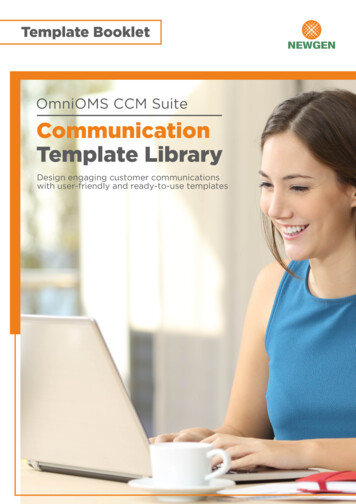
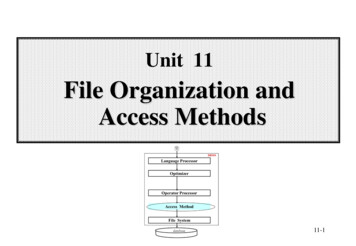
![[MS-FASOD]: File Access Services Protocols Overview](/img/10/5bms-fasod-5d.jpg)

